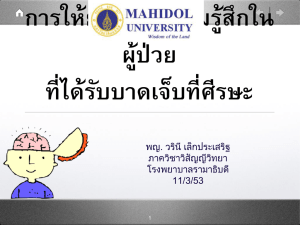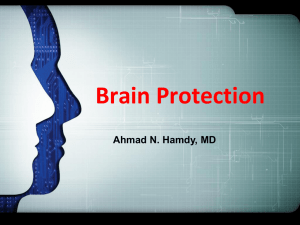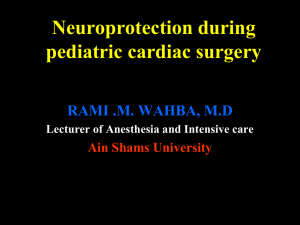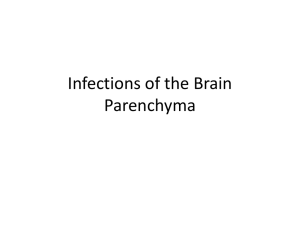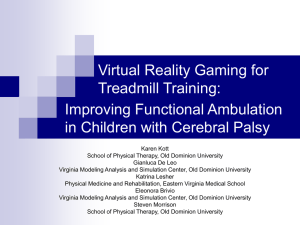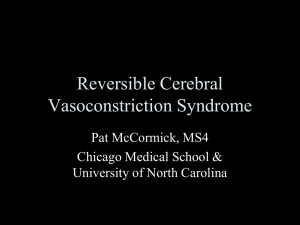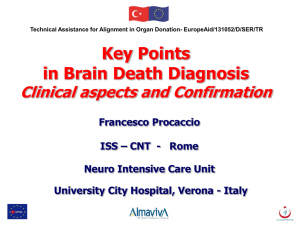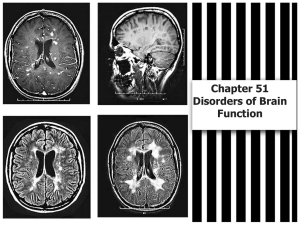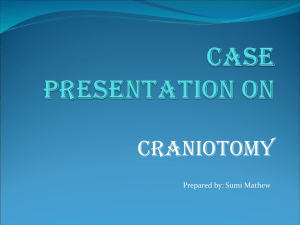Systemic Inflammatory Response Syndrome in Cardiopulmonary
advertisement
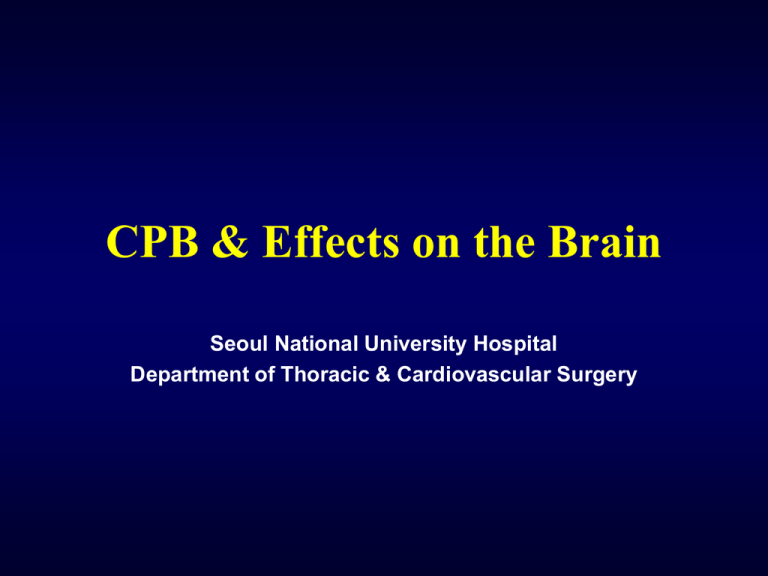
CPB & Effects on the Brain Seoul National University Hospital Department of Thoracic & Cardiovascular Surgery Central Nervous System Nervous regulation The central nervous system (CNS) performs three types of functions: (1) Mental processes, such as thought or emotion; (2) Actions on the external environment, such as locomotion, or other actions requiring skeletal muscle work; (3) Actions on the internal environment, Central Nervous Systems Functional anatomy Spinal Cord Structure • Structure of the spinal cord; The intermediolateral gray matter is shown in color. This is the region in which sympathetic preganglionic neurons are located. Central Autonomic Control Hierarchy • Limbic cortex and amygdala • Hypothalamus • Brainstem ; The brainstem consists of three anatomically distinct regions: midbrain, pons, and medulla. They are linked at the core by reticular formation. Limbic Cortex & Amygdala Functions • These very high centers function both as a brake on automatic responses that may accompany emotional states, such as fear, rage, embarrassment, or sexual desire, and as direct activators of the system. • The latter is seen prominently in two circumstances: (1) in the responses of blood pressure, sweat glands, or genitalia to dreams and fantasies and (2) in the volitional control of resting autonomic functions during states of deep meditation. • In this state, metabolic rate, heart rate, arterial blood pressure, and distribution of blood flow can all be modified by application of conscious mental effort Hypothalamus Basic functions • It is an interface between the autonomic nervous system and higher nervous centers, on the one hand, and the endocrine system, • It coordinates whole-body autonomic responses to behavioral drives (such as fear) or to input from autonomic and environmental sensors. • This coordination involves the following: Integration to hunger, thirst, and sexual drives Integration of thermoregulation Integration of defence reactions Control of several endocrine secretions, Brainstem Structures • Midbrain. The midbrain acts as a conduit for ascending and descending fibers. It also harbors nuclei that are associated with complex neurologic patterns • Pons. The pons contains nuclei for several cranial nerves as well as reflex centers for cardiovascular and respiratory control. • Medulla. This region contains many nuclei, among them the nucleus ambiguous and dorsal motor nucleus, which are the origins of cranial nerves IX & X. It contains rostral ventrolateral medulla, a major originating site for sympathetic outflow to spinal cord. • Reticular formation. This is a collection of both ascending and Spinal Cord Function • Spinal cord is a collection of nerve cell bodies & axons • Gray matter consists mostly of neuronal cell bodies and is subdivided on each side into three regions: (1) the dorsal horn is the region where sensory afferents synapse with spinal neurons, (2) the ventral horn contains groupings of motor neurons that supply skeletal muscle, and (3) the intermediate zone lies between the other two and contains local afferent or efferent interneuron linkages as well as cell bodies of autonomic preganglionic nerves. • White matter of the spinal column is the nervous tissue that surrounds the gray matter. It is composed chiefly of ascending and descending axons, arranged into fascicles and columns: (1) the dorsal column contains principally ascending fibers, (2) the ventral column contains mainly descending fibers, and (3) the lateral column contains a mixture of ascending and descending fibers. Spinal Cord Structure • The intermediolateral gray matter is shown in color. This is the region in which sympathetic preganglionic neurons are located. DC = dorsal column; LC = lateral column; VC = ventral column. Spinal Nerves Structure Spinal Nerves Structure • Pre- and postganglionic autonomic fibers synapse either in a paravertebral ganglion or a peripheral ganglion. Neurotransmitters • Diversity of neurotransmitters and function Efferent Fibers Characteristics of differences • Preganglionic fibers ; Cell bodies of autonomic efferent nerves are located in the brainstem or the spinal cord. Their location and the location of the associated ganglion form two of the criteria by which the system is classified into sympathetic or parasympathetic divisions • Postganglionic fibers ; Postganglionic fibers project directly to the effector organ target cells where they form a synapse. In sympathetic postganglionic nerves, this Autonomic Nervous System Autonomic Nervous System Divisions Two major divisions of the autonomic nervous system are the sympathetic and parasympathetic nervous systems. They differ from each other in some anatomic features and in their respective target organ neurotransmitters • Adrenergic control mechanism • Cholinergic control mechanism • Nitroxidergic control mechanism Adrenoreceptors Cholinoreceptors • A variety of insecticides are anticholinesterases and, thereby, act to prolong the action of acetylcholine. Cerebral Blood Flow Dererminants 1. Threshold cerebral blood flow at normothermia under 30ml/100g/min ; brain acidosis occurs less than 20ml/100g/min ; loses electrical activity less than 10ml/100g/min ; loses further cellular membrane integrity 2. Cerebral blood flow during deep hypothermia (20 C) less than 7ml/100g/min ; results in reduction of cerebral O2 metabolism 9 ml/100g/min is necessary for aerobic metabolism (25-30% of normal) 3. Full-flow perfusion at hypothermia Metabolic rates for oxygen lower than those with 40ml/kg/min perfusion The ratio of the glucose to oxygen metabolic rates are also increased this luxury perfusion ---- paradoxical harm of luxury perfusion (cerebral vasoconstriction that would harm the microcirculation during deep hypothermia due to downregulation of cerebral blood flow ) Paradoxical acidosis & brain embolism at extreme velocity 4. Brain averages 2% of total body weight, 14% of cardiac output, 20 % of total O2 consumption Cerebral Collateral Circulation Collateral flow anatomy 1. Intracranial Circle of Willis 2. Extracranial Vertebral arteries Internal thoracic arteries Intercostal arteries Congenital Heart Disease Etiology of neurologic deficits • Incompletely understood, & likely to be multifactorial • Clinical evidence points to the combination of hypoxemia and low cardiac output in the early neonatal period as a risk factor for periventricular leukomalacia • This encompasses a spectrum of lesions characterized by multiple areas of necrosis in the periventricular white matter • In infants with complex congenital heart defects, preoperative cerebral blood flow (CBF) is often diminished, and that lower levels of CBF are associated with periventricular leukomalacia. Open Heart Surgery Neurologic injury • Neurologic injury is the second most common reason for death in open heart operations • Significant neurologic injury was observed in 2% to 5% of patients, whereas mild cognitive dysfunction was seen in 70% of patients in the early stage • Extracorporeal circulation does not cause changes in brain blood circulation, but hemodilution and decrease in oncotic pressure lead to edema in the brain and in other organs • Cerebral ischemia due to microemboli or macroemboli, systemic inflammatory response, and cerebral hypoperfusion during cardiopulmonary bypass (CPB) causes impairment in the blood brain barrier. Brain Temperature Determinants of changes 1. Cerebral blood flow 2. State of metabolic rate 3. Heat exchange with environment Basic Effects of Hypothermia Gas transport • The solubility of gases in liquids is inversely related to temperature, and therefore substantially more oxygen and carbon dioxide will be carried in physical solution in the blood under hypothermic conditions • As temperature is lowered, oxyhemoglobin dissociation curve shifts to left, so that for a given partial pressure of oxygen in the tissues, less of the gas is unloaded from the hemoglobin • Decreasing temperatures increase the carrying power of blood for carbon dioxide through an increased activity of the blood buffers Hypothermic Circulatory Arrest Effects on CNS • Hypothermia is the most efficient measure to prevent or reduce ischemic damage to the central nervous system when blood circulation is reduced • The CNS system has a high metabolic rate and limited energy stores, which make it extremely vulnerable to ischemia • The CNS is the most sensitive to ischemia, attention has been mainly centered on neurologic outcome when perfusion is reduced Hypothermic Circulatory Arrest Effects on brain • Hypothermic circulatory arrest results in global brain ischemia followed by ischemia-reperfusion injury • This leads to loss of wall integrity in microvasculature and fluid leakage; ie, fluid escaping the intravascular space into the brain tissue • The resulting brain edema and elevated intracranial pressure further decrease brain tissue perfusion by compressing and occluding small vessels. • Adherent neutrophils and microvascular thrombosis blocking the small cerebral vessels may also play a role in the impairment of cerebral blood flow Brain Protection Hypertonic saline dextran • Hypertonic saline dextran is used with encouraging results in the treatment of elevated intracranial pressure and head trauma with hypotension • Its neuroprotective properties have been demonstrated in animal models of brain ischemic injury • Hypertonic saline dextran increases plasma osmolarity has an inotropic effect on the heart, causes vasodilation, is associated with better tissue perfusion and oxygenation, and attenuates the ischemia-reperfusion injury • Dextran may have its own beneficial immunomodulatory effects that hydroxyethyl starch is lacking, possibly making HSD superior Brain Protection Hypertonic saline • Hypertonic saline, its rapid and powerful hemodynamic effects, however, last only 30 to 60 minutes. • Hypertonic saline was combined with a hyperoncotic substance such as dextran (HSD) or hydroxyethyl starch, yielding a more sustained effect which lasts up to 3 to 4 hours • Hypertonic saline has a direct effect on the inflammatory response, suppressing neutrophil activation and decreasing susceptibility to sepsis after hypovolemic shock • Indeed, hypertonic saline has been shown to downregulate the expressions of some key adhesion molecules of neutrophils Carbon Dioxide on Hypothermia Roles in metabolism • Carbon dioxide is the major end product of cellular metabolism, continuously being produced by all cells. • Increased solubility of carbon dioxide which is 20 times more soluble than oxygen • Decreased dissociation and reduction of hydrogen ion activity • Increased carrying power of blood for carbon dioxide by blood through an increased ability of blood buffers • Decrease in the base-binding capacity of protein by decreased ionization process of protein and increase in the amount of free base or hydrogen ion acceptor Hypothermic Circulatory Arrest Management strategies • • • • • • Cerebral metabolic rate Direct & secondary ischemic injury Cerebral blood flow Management of temperature Neurologic injury after DHCA Prevention of ischemic neurologic damage Hypothermia on Brain Effects • Hypothermia reduces the metabolic rate of the CNS and lengthens the period of the tolerated ischemia. • The CNS almost exclusively extracts its energy through the aerobic process of glycolysis • The uptake of oxygen or glucose is consequently a reliable parameter of the metabolic rate • Reduction of metabolic rate in relation to temperature espouses an exponential curve with a greater drop at high temperatures (about 6 % for 1 C around 37 C) • Clinically, electrocerebral silence is obtained at a mean nasopharyngeal temperature of 17.5 C , but the minimal nasopharyngeal temperature to obtain silence in all patients was 12.5 C Hypothermic Circulatory Arrest Limitations • Duration of safe circulatory arrest at a given temperature should not be seen as a clear-cut time period, with successive biochemical alterations, followed by ultrastructural, then structural changes • Recovery of oxygen consumption is already impaired after 15 minutes of ischemia at 18 C, and cerebralproduced lactate is detectable after 20 minutes of ischemia • Eletromagnetic signals of phosphocreatine decreases rapidly, followed by that of adenosine triphosphate, after circulatory arrest. These signals become hardly detectable after 32 to 36 minutes of ischemia at 15 C in animal. Parallel to their disappearance, signals of inorganic phosphate & pH progressively rise within cell Ischemic Brain Injury Direct injuries • Cellular injury occurs because of a rapidly occurring intracellular acidosis and a more progressive dissipation of ionic gradients across membranes after cessation of blood delivery to neuron • Accumulation of calcium within cell and attraction of osmotically obligated water are striking • Endothelial cells are also sensitive to ischemia and vasoactive factors activation & productions are impaired after ischemia and results in increased cerebral vascular resistance Ischemic Brain Injury Secondary injuries • Reperfusion injuries (secondary injuries) operate at a cellular(oxygen provoke reactive free radicals) & at a vascular (recirculation of blood induce aggregation & adhesion of thrombocytes & neutrophil to endothelium) level and these cellular complexes release potent inflammatory mediators & vasoconstrictor agents • Electrical hyperactivity of the brain after ischemia can produce extensive damage, a cellular energetic mismatch and the release of toxic neurotransmitters, paradoxically vulnerable in the extracellular space • Protracted cellular dysfunction and apoptosis lead to a delayed neuronal death Postoperative Seizure Risk factors • Children with CHD are an at-risk population for neurodevelopmental problems, with a high incidence of microcephaly & congenital structural abnormalities, as well as acquired lesions. • Cerebral hypoperfusion and low cerebral oxygen saturation are present in some children before surgical intervention. • Postoperative events, such as low cardiac output, hypoxia, and hypotension, can cause CNS injury or exacerbate existing injury. • The use, duration, or both, of DHCA alone does not explain the incidence of postoperative seizures Postoperative Seizure Risk factors • Factors such as polymorphisms in genes regulating the inflammatory response or neuronal repair are likely important determinants of this variability. • It is probably not possible to define a safe threshold for exposure to DHCA, CPB, or both for all children below which no injury will occur. • Inability to identify or quantify an injury and its sequelae does not mean an injury has not occurred. As children mature, subtle deficits affecting learning, attention, behavior, and other higher functions become apparent. Cerebral Blood Flow Low-flow & intermittent perfusion • Prevent anaerobic glycolysis and intracellular acidosis, and prolong cerebral tolerance to ischemia • Minimal flow rate in humans is 11ml/kg/min at 18 C, but in clinical practice, minimal flow rate is ranging 5 to 30ml/kg/min at 18 C • Metabolic homeostasis is maintained throughout when intermittent perfusion was established after short period of ischemia (every 20 minutes at 18 C for 2 minutes perfusion) Pulsatile flow • Provides hemodynamic advantages over nonpulsatile perfusion that become significant with borderline pressure and flow Blood Gas Managements Alpha-stat strategy (patient temperature uncorrected) • Alpha-stat management (mechanism prevailing in reptiles) aims at maintaining normal acidemia and blood gases ( a pH of 7.40 and a PaCO2 of 40mmHg) in the rewarmed (37C) blood. In vivo, the hypothermic blood is alkalemic and hypocapnic • Alpha-stat management preserves autoregulation of brain perfusion and optimizes cellular enzyme activity. • In alkalemia and hypothermia, oxyhemoglobin dissociation is shifted to right, corresponding to an increased affinity of oxygen for hemoglobin. • At deep temperature reduction, oxygen diluted in blood represents the major source of oxygen to tissues • When a pH more alkaline than alpha stat (alkaline-stat regulation), brain tissue pH was more higher Blood Gas Managements pH-stat strategy (patient temperature corrected) • The pH-stat managements (mechanism prevailing in hibernating animals) aims at maintaining normal values in vivo, in the hypothermic blood. When rewarmed to 37C, the blood becomes acidemic & hypercapnic • The pH-stat stategy results in a powerful & sustained dilation of cerebral vessels because of high level of carbon dioxide • Autoregulation of brain perfusion is lost & cerebral blood flow greatly increased, resulting a quick & even cooling • Hypercapnia shifts oxyhemoglobin dissociation curve toward the left & results in an increased availability of oxygen to tissues Management of Temperature Cooling • A slow rate of cooling or rewarming and a high blood flow are the two factors ensuring homogenous changes of the body temperature. • Occlusive vascular disease & altered vascular reactivity may reduce cerebral perfusion and delay temperature equilibration • Oxygen availability is reduced during hypothermia and parallel decrease in metabolic rate is likely to preserve a balance between availability & requirement of oxygen • Increased hematocrit could compensate for decreased oxygen availability related to hypothermia , so cooling should be performed slowly & with an adequate Hct. Management of Temperature Rewarming • Restart perfusion slowly after circulatory arrest, ensuring optimal hemodynamic conditions, and avoiding cerebral hyperactivity • Initial “cold blood-low pressure reperfusion” with a sufficient Hct. washes out metabolites, buffers free radicals, and provides substrates before cerebral electrical activity • Hyperglycemia, stimulated by release of endogenous catecholamines, increases intracellular acidosis & prevent metabolic homeostasis • During rewarming , cerebral vascular resistance & energetic metabolism are impaired in proportion to ischemia, glucose is in part diverted to less efficient anaerobic pathway, and oxidative phosphorylation is disturbed • This vulnerable period can last for 6-8 hours after reperfusion, and hyperthermia exacerbates cerebral activity & disturbs cellular metabolism, so a relative hypothermia is beneficial Acid-Base Regulatory Strategy pH-stat strategy • • • • Aim ; constant pH, Total CO2 ; increased Intracellular state ; acidosis Alpha-imidazole & buffering ; excess(+) charge & Alpha-stat strategy • • • • Aim; constant OH/H, Total CO2 ; constant , Intracellular state ; neutral Alpha-imidazole & buffering ; constant net charge & pH-STAT Advantages • Enhance cerebral blood flow • Enhance cerebral oxygenation • Maintain normal intracellular pH during cooling • Improve brain cooling & faster recovery of intracellular pH, cerebral high energy metabolites and oxygenation after HCA pH-STAT Disadvantages • Detrimental to cardiac & brain function • Increase the risk of cerebral embolism • Increase the regional ischemia (steal through collateral) Alpha-STAT Advantages • Maintain cerebral autoregulation • Maintain cerebral flow/metabolism coupling • Less neuropsychological damage • Reduction of global cerebral perfusion in low temperature is disadvantageous Alpha-STAT Disadvantages • • • • Less metabolic suppression in hypothermia Intracellular alkalosis during cooling Need of higher hematocrit Disturbed cerebral oxygenation during fast rewarming Optimal Neurologic Protection Variables • • • • • • • • • Perfusion pressure Flow rate Duration of cooling Duration of circulatory arrest Hematocrit Ultrafiltration Blood gas strategy Presence of collateral flow Impact of age pH-STAT Advantages • • • • • • • • • • • • Better brain cooling efficacy & slower cortical deoxygenation Increase the prearrest Sco and Sco half-life Increase cortical O2 supply & slow cortical oxygen consumption Improve the neurologic outcome in pediatric patients Similar nerodevelopmental outcome Inhibit lactate build-up and glutamate excitotoxicity during arrest and early reperfusion Improve the cerebral perfusion during rewarming Increase the cerebral tissue oxygenation Similar leukocyte/Endothelial interaction during hypothermic bypass Better immature brain protection Better outcome in immature brain tissues with AP collateral. Increased SJVo2 & decreased AV oxygen and glucose difference Mechanisms of Brain Protection By changes in temperature 1. Alterations in metabolic rate 2. Alterations in membrane stability ( including blood-brain barrier ) 3. Alterations in membrane depolarization 4. Temperature-induced ion homeostasis ( including calcium fluxes ) 5. Neurotransmitter release or uptake 6. Enzyme function (phospholipase, xanthine oxidase, or NO synthase) 7. Free radical production or endogenous scavenging Hypothermic Circulatory Arrest Focal neurologic injury • Due to interruption of blood in a terminal vascular territory usually following embolism of material or gas • Less frequently, a prolonged subliminar perfusion of the brain can result in a localized necrosis in the transition area between two vascular territories (watershed lesion) • The clinical expression is typical motor-sensory deficit, aphasia, or cortical blindness • Age, atherosclerosis, and manipulation of aorta are risk factors, but not duration of circulatory arrest Hypothermic Circulatory Arrest Diffuse neurologic injury • Due to a global cerebral ischemia that induces various levels of cellular dysfunction, and areas with reduced perfusion (atherosclerosis), or increased metabolic activity (hyppocampus), are most vulnerable • The spectrum ranges from transient confusion, stupor, delirium, agitation, and debilitating ones like seizures, parkinsonism, and coma • Age, improper conduct of CPB, and prolonged duration of circulatory arrest are common risk factors • Disorders that impair vascular reactivity and cerebral autoregulation, like diabetes, and hypertension, has been associated with increased incidence Brain Protection Methods • • • • • • • • • • Documented. Possible. Hypothetical Slow cooling & rewarming 0 Ice-packing of the head 0 Wait for electrical silence 0 Continuous antegrade perfusion 0 Intermittent antegrade perfusion 0 Continuous retrograde perfusion 0 High hematocrit 0 Pharmacologic blockade of neurotransmitter 0 Pharmacologic enhance of vascular function 0 Pharmacologic prevention of reperfusion injury 0 Neuroprotection of Valproate Mechanisms • Valproate acts on phosphatidylinositol 3-kinase/protein kinase B pathway in an insulin-dependent manner to protect against apoptosis in cerebellar granule cells • In addition, lipid peroxidation and protein oxidation during oxidative stress are reduced by chronic treatment with valproate • The expression of endoplasmic reticulum stress proteins, which inhibit oxygen free radical accumulation, is enhanced after treatment with valproate Methods for Brain Protection Antegrade cerebral perfusion • Perfusate temperature is usually set at 18C and the flow is 1020ml/kg/min or pressure between 40-50mmHg in radial artery • Left common and subclavian artery be occluded to avoid a steal Retrograde cerebral perfusion • The risk rises after 60 minutes of DHCA, perhaps at the extinction of intracellular energy substrates Integrated perfusion • Circulatory arrest is established only after electrical silence and jugular venous saturation over 95% • During 10-20 minutes preceding circulatory arrest, temperature of the perfusate lowered to 13 C to further reduce brain temperature • A short period of retrograde cerebral perfusion can be performed to wash out emboli of the arch arteries before antegrade perfusion • Arch arteries are connected to a graft for antegrade perfusiom Cardiopulmonary Bypass Effect on the brain • Generally, transient & permanent neuro or neuropsychiatric injury occurs in as many as 25% of all infants undergoing cardiopulmonary bypass with or without circulatory arrest. • Although the subtle neurologic injury is common in adult undergoing CPB, the physiologic impact of bypass in adults is very different from that of children. Perfusion Strategies Effect on the brain 1. Non-pulsatile vs. pulsatile perfusion 2. Aortic and venous cannulation Venous obstruction by large, stiff venous cannulas Preferential flow with aortic cannula placement 3. Air embolism Cannulation Aortic cross-clamp removal High pump flow rate Use of agents that increase perfusion pressure Cardiopulmonary Bypass Brain injury in adults 1. Atheromatous emboli 2. Fixed cerebrovascular stenosis 3. Moderate hypothermia is used. 4. Relative vasodilation by PH-stat 1) Increased cerebral delivery of embolic material 2) Steal blood flow away from post-stenotic area Cardiopulmonary Bypass Brain injury in infants 1 Hypoperfusion during low or no blood flow 2 Deep hypothermia is used. 3 Cerebral oxygen supply will be enhanced . 4. High incidence of air embolism (1) Presence of intra- and extracardiac communication between systemic and pulmonary circulation (2) Increased amount of intracardiac surgery Cardiopulmonary Bypass Risk factors of brain injury in children • Intra and extracardiac communication • Increased amount of intracardiac surgery • Use of pH strategy (cerebral hyperemia, increased brain edema) • Increased metabolic demand for neuronal growth, myelinization in neonate Ischemic Brain Injury At normothermic state 1. 2. 3. 4. 5. 6. 7. 8. ATP, phosphocreatine depletion Release of excitatory neurotransmitters Altered ionic permeability Calcium influx Phospholipase C & A2 release free fatty acid, such as arachadonic acid Leukotriene level increase dramatically after ischemia Nucleases become active after ischemia Enzymatic breakdown of ADP & AMP Cardiopulmonary Bypass Hypothermic effects on the brain 1. Cerebral blood flow decreases in a linear relationship with temperature. 2. Cerebral metabolism decreases exponentially with a reduction in brain temperature. 3. Flow / metabolism coupling ratios increase with decreasing temperature. 4. Effects of CO2 regulation 5. CO2 management alpha-stat, pH-stat, alkaline stat Ischemic Brain Injury Effect of hypothermia • Preventing excitatory neurotransmitter release • Restricting membrane permeability • Preventing calcium entry into the cell Hypothermic Brain Injury Etiology of brain injury • Temperatures of 10℃ and below are probably not deleterious as long as hemodilution is used. • In general, capillary sludging, massive air emboli, inadequate cerebral cooling, cerebral steal appear to be more important factors. Brain Death Etiologies of cardiac dysfunction 1. Direct cardiac myocyte injury 2. Catecholamine induced myocardial damage 3. Impairment of the beta-adrenoreceptoradenylyl cyclase system, as well as hormone depletion 4. Systemic vascular resistance decrease as a consequence of loss of sympathetic tone Cerebral Function with CPB Effects of hemodilution • Degree of hemodilution during CPB and stroke is biologically plausible • Hemodilution may increase embolic load to the brain by increasing cerebral blood flow (which is two to three times higher at a hematocrit of 15% than at 25%) • The effects of hemodilution on oxygen delivery is impaired in ischemic brain cells. • Cells in ischemic areas of the brain may not receive adequate supplies of oxygen with severe hemodilution to levels that are commonly used during CPB Cerebral Ischemic Injury Prevention by hypothermia 1. The normothermic brain 2. The hypothermic brain 3. Deep hypothermic circulatory arrest with intermittent perfusion 4. Low flow CPB 5. Direct brain injury from hypothermia Neural damage after Ischemia Pathophysiology • • • • • • • Excitotoxicity Cell death mediated by nitrous oxide Calcium overload in the cell Eicosanoid formation Inflammatory reaction Apoptosis Free radicals Hypothermia on Brain Protective effect mechanism • Preservation of high energy phosphate store • Preventing excitatory neurotransmitter release( glutamate, dopamine ) • Restricting membrane permeability • Preventing calcium entry into the cell Glucose Regulation Effects of hypothermic CPB • Conclusive evidence of the detrimental effect of hyperglycemia during complete, incomplete and focal cerebral ischemia • The role of glucose in potentiating cerebral injury appears due to two factors ; ATP utilization and lactic acidosis (inhilbitor of the enzyme phosphofructokinase). Cardiopulmonary Bypass Rewarming from hypothermia 1. In response to a period of hypothermic, hemodiluted, nonpulsatile perfusion, brain responds with hyperemia, increased oxygen extraction & increased metabolism during rewarming and weaning period of CPB. 2. After TCA, cerebral blood flow, & cerebral metabolism are reduced below baseline measurements and oxygen extraction doesn’t increase with reperfusion, the rate at which brain recovers ATP, pH, & PO2 is markedly delayed when compared to continuous flow CPB. 3. By increasing efficiency of pump flow (pulsatility), increasing pump flow rate or increasing hematocrit, oxygen delivery should improve during rewarming. Cerebral Ischemia Effect of hyperglycemia • Although a strong argument can be made for the detrimental effects during ischemia, there is very little evidence supporting worsening neurologic outcome in hyperglycemia during CPB or TCA. • One can not ascribe the neuropathologic insult to hyperglycemia alone. • The damaging effect may well be age-related and other associated factors (flow, pressure, periods of hypoxia, thrombocytopenia, vascular responses). Cerebral Ischemia Effect of hypoglycemia 1. Hypoglycemia is a frequent concern in neonate and children during the perioperative period. * Reduced hepatic function * Decreased glycogen storage 2. The hypoglycemia can result in neurologic injury throughout the perioperative period. 3. The addictive effect of hypoglycemia, even if mild, may cause additional alterations in cerebral autoregulation and culminate in increased cortical injury. Cardiopulmonary Bypass During arch reconstruction • Hypothermia at 18 ºC • Low flow rate without circulatory arrest * 0.4 ~ 0.8 L/min/BSA * 20 ml/kg/min • Route of brain perfusion * Innominate artery through distal ascending aorta * Ascending aorta with proximal arch clamp * Through the shunt of innominate artery Cerebral Function Principles of regulation • Normally, cerebral blood flow is independent of cerebral perfusion pressure over a range of 50-150mmHg, with the primary determinant of flow being cerebral metabolic rate. Outside of this range of autoregulation, CBF is directly related to CPP. • Variables such as the methods of acid-base management, mean arterial pressure, flow rate, and type of perfusion, and their effect on cerebral circulation remain controversial. • Global increase in CBF due to elevation of PaCO2, and associated cerebral vasodilation may critically reduce perfusion pressure and jeopardize of areas of brain dependent on flow through stenosed vessels. • Cerebral hyperperfusion may potentially deliver more gaseous and particulate microemboli into cerebral circulation. • Cerebral blood flow is also affected by anesthetic agents. Ph-stat in Infants Explanations for protection • Extracellular acidosis may inhibit cerebral excitotoxicity. • CO2 exert a direct suppressive effect on brain metabolic rate of oxygen. • Higher intra-ischemic carbon dioxide appears neuroprotective. • Hypercarbic acidotic reperfusion improves recovery of systolic ventricular function and coronary blood flow by decreased uptake of lethal calcium and coronary vasodilation beneficial. Intermittent Circulatory Arrest Principles of intermittent perfusion • A certain periods of reperfusion does not result in full repletion of intracerebral high energy phosphate stores or resortation of intracellular pH. • A second period of hypothermic arrest or perhaps a brief period of hypotension in the postoperative period may results in greater neurologic injury than anticipated because of reduced cerebral energy stores and altered vascular responses after TCA. Intermittent Circulatory Arrest Advantage & rationale 1. Brain is an organ with a high energy demand &over 90% of energy produced by mitochondria in the brain is derived from oxygen & glucose. 2. Brain oxygenation steadily decreased during retrograde cerebral perfusion and insufficient supply. 3. Establishment of optimal periods of circulatory arrest & recirculation to prevent anaerobic metabolism to reduce ischemic brain damage 4. Aerobic metabolism is maintained during the 1st 20 minutes of DHCA but rapidly changed over to anaerobic metabolism after the 1st 30minutes of DHCA. 5. Brain edema increases as anaerobic metabolism continues. Cardiopulmonary Bypass Cerebral vulnerability Microcirculatory dysfunction after TCA Increased capillary permeability Increase metabolic rate after TCA (hyperthemia) Decreased substrate delivery ( hypoglycemia) Worsening right ventricular function (elevation of venous pressure) Hypothermic Circulatory Arrest Development of seizures 1. The frequency of seizures was found to be associated with the duration of circulatory arrest. 2. The perioperative seizures have little effect on subsequent cognitive development. (?) 3. There is a strong correlation between occurrence of perioperative seizures & retarded motor development. Hydroxyethyl Starch Natures • Hydroxyethyl starch solution is an artificial colloidal solution, and it causes transport of water into intravascular space • Iinhibit leukocyte adhesion and chemotaxis and decreased vascular permeability in endothelial tissue • These kinds of solutions prevent the capillary leakage developed during CPB. • Solutions like HES can prevent the activation of inflammatory process during CPB as well as the following leukocyte activation and tissue edema. • HES increased prothrombin time, activated partial thromboplastin time, coagulation time, and bleeding time S-100 Protein Nature 1. A type of protein synthesized in the astroglial cells in the CNS 2. Structural damages to the brain causes a selective leakage into the cerebrospinal fluid. 3. Less selective permeability of the blood-brain barrier & higher protein turnover in the children 4. Low renal excretion rate in the young children 5. Biologic half-life of S-protein has been estimated about 2 hours.
